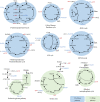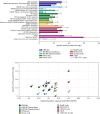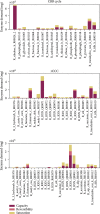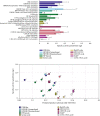In-Depth Computational Analysis of Natural and Artificial Carbon Fixation Pathways
- PMID: 37849946
- PMCID: PMC10521678
- DOI: 10.34133/2021/9898316
In-Depth Computational Analysis of Natural and Artificial Carbon Fixation Pathways
Abstract
In the recent years, engineering new-to-nature CO2- and C1-fixing metabolic pathways made a leap forward. New, artificial pathways promise higher yields and activity than natural ones like the Calvin-Benson-Bassham (CBB) cycle. The question remains how to best predict their in vivo performance and what actually makes one pathway "better" than another. In this context, we explore aerobic carbon fixation pathways by a computational approach and compare them based on their specific activity and yield on methanol, formate, and CO2/H2 considering the kinetics and thermodynamics of the reactions. Besides pathways found in nature or implemented in the laboratory, this included two completely new cycles with favorable features: the reductive citramalyl-CoA cycle and the 2-hydroxyglutarate-reverse tricarboxylic acid cycle. A comprehensive kinetic data set was collected for all enzymes of all pathways, and missing kinetic data were sampled with the Parameter Balancing algorithm. Kinetic and thermodynamic data were fed to the Enzyme Cost Minimization algorithm to check for respective inconsistencies and calculate pathway-specific activities. The specific activities of the reductive glycine pathway, the CETCH cycle, and the new reductive citramalyl-CoA cycle were predicted to match the best natural cycles with superior product-substrate yield. However, the CBB cycle performed better in terms of activity compared to the alternative pathways than previously thought. We make an argument that stoichiometric yield is likely not the most important design criterion of the CBB cycle. Still, alternative carbon fixation pathways were paretooptimal for specific activity and product-substrate yield in simulations with C1 substrates and CO2/H2 and therefore hold great potential for future applications in Industrial Biotechnology and Synthetic Biology.
Copyright © 2021 Hannes Löwe and Andreas Kremling.
Conflict of interest statement
We declare no competing interests.
Figures










Similar articles
-
Detailed profiling of carbon fixation of in silico synthetic autotrophy with reductive tricarboxylic acid cycle and Calvin-Benson-Bassham cycle in Esherichia coli using hydrogen as an energy source.Synth Syst Biotechnol. 2019 Sep 10;4(3):165-172. doi: 10.1016/j.synbio.2019.08.003. eCollection 2019 Sep. Synth Syst Biotechnol. 2019. PMID: 31528741 Free PMC article.
-
Engineering the Calvin-Benson-Bassham cycle and hydrogen utilization pathway of Ralstonia eutropha for improved autotrophic growth and polyhydroxybutyrate production.Microb Cell Fact. 2020 Dec 11;19(1):228. doi: 10.1186/s12934-020-01494-y. Microb Cell Fact. 2020. PMID: 33308236 Free PMC article.
-
Topological Analysis of the Carbon-Concentrating CETCH Cycle and a Photorespiratory Bypass Reveals Boosted CO2-Sequestration by Plants.Front Bioeng Biotechnol. 2021 Nov 1;9:708417. doi: 10.3389/fbioe.2021.708417. eCollection 2021. Front Bioeng Biotechnol. 2021. PMID: 34790651 Free PMC article.
-
Creating new-to-nature carbon fixation: A guide.Metab Eng. 2024 Mar;82:12-28. doi: 10.1016/j.ymben.2023.12.012. Epub 2023 Dec 29. Metab Eng. 2024. PMID: 38160747 Review.
-
Yeast metabolic engineering for carbon dioxide fixation and its application.Bioresour Technol. 2022 Feb;346:126349. doi: 10.1016/j.biortech.2021.126349. Epub 2021 Nov 17. Bioresour Technol. 2022. PMID: 34800639 Review.
Cited by
-
Corrigendum to "In-Depth Computational Analysis of Natural and Artificial Carbon Fixation Pathways".Biodes Res. 2021 Nov 16;2021:9756012. doi: 10.34133/2021/9756012. eCollection 2021. Biodes Res. 2021. PMID: 37849949 Free PMC article.
-
Perspectives on improving photosynthesis to increase crop yield.Plant Cell. 2024 Oct 3;36(10):3944-3973. doi: 10.1093/plcell/koae132. Plant Cell. 2024. PMID: 38701340 Free PMC article. Review.
-
Seven critical challenges in synthetic one-carbon assimilation and their potential solutions.FEMS Microbiol Rev. 2025 Jan 14;49:fuaf011. doi: 10.1093/femsre/fuaf011. FEMS Microbiol Rev. 2025. PMID: 40175298 Free PMC article. Review.
-
Improving plant productivity by re-tuning the regeneration of RuBP in the Calvin-Benson-Bassham cycle.New Phytol. 2022 Oct;236(2):350-356. doi: 10.1111/nph.18394. Epub 2022 Aug 7. New Phytol. 2022. PMID: 35860861 Free PMC article. Review.
-
Systematic design and evaluation of artificial CO2 assimilation pathways.Synth Syst Biotechnol. 2025 May 28;10(4):1107-1118. doi: 10.1016/j.synbio.2025.05.009. eCollection 2025 Dec. Synth Syst Biotechnol. 2025. PMID: 40606856 Free PMC article.
References
-
- World Bank, and Food and Agriculture Organization of the UNAgricultural land (% of land area), 2016
-
- Zhu X. G., Long S. P., and Ort D. R., “What is the maximum efficiency with which photosynthesis can convert solar energy into biomass?,” Current Opinion in Biotechnology, vol. 19, no. 2, pp. 153–159, 2008 - PubMed
-
- Wilson R. H., and Whitney S. M., “Improving CO2 fixation by enhancing Rubisco performance,” Directed Enzyme Evolution: Advances and Applications, Springer International Publishing, pp. 101–126, 2017
LinkOut - more resources
Full Text Sources

